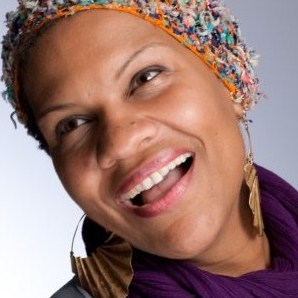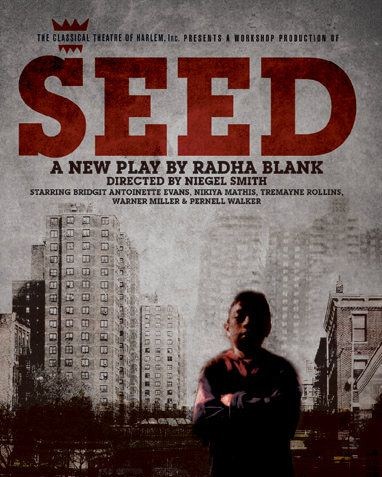
By: Isha “Ice” Cole
—
The crack epidemic in America erupted in the 1980’s, causing destruction in many of the nation’s big cities. Children were born from mothers addicted to the drug, fathers were in jail, and people were being killed. Under the The Anti-Drug Abuse Act of 1986, the government implemented harsh penalties for suppliers of crack cocaine. African-Americans made up more than 80% of federal crack cocaine convictions, ruining many families and urban communities.
The powerful off-Broadway play Seed, penned by award-winning playwright Radha Blank and directed by Niegel Smith, reflects many of the issues that spawned from the spread of crack cocaine. Blank was a Teaching Artist for 15 years, and has first-hand experience in the various topics tackled in the play.
Seed takes the audience through an emotional journey through the eyes of the main characters. The story is told at many points through Hip-Hop rhyme, and is accompanied by vivid background images set in Harlem, New York. Urblife.com recently got the word from Radha Blank about her personal memories of the crack epidemic, Hip Hop’s influence, the real story of Harlem and more!
Tell us about your play Seed.
Radha Blank: Seed is a Harlem story. It’s what I would call my love letter to Harlem. It centers around this social worker who becomes invested in the welfare of a child genius from the projects. While trying to help him along she confronts his young mother, so it becomes a tug of war between these two women. One woman who is middle class, in her 40’s, and childless; and another woman who is in her 20’s, from the projects, and was a teen mother. They’re both kind of battling over who knows what’s best for this boy.
Can you tell us a little bit about the main characters in this play, and why they’re important to the overall story?
RB: Through the characters in the play I could speak to certain issues that have always caused me concern. Some of the characters represent my concern about the welfare of children especially those from deprived communities. Can you be really smart and supported in a community like that?
That’s represented through Chee Chee who is 12, but has the learning ability of someone beyond his years. He has the ability to retain information and that kind of information is what makes him like a genius. Through Chee Chee I think I speak to our values or lack of values in education.
The social worker, Anne, represents the point of view of someone whose job it is to look out for children. Chee Chee’s parents speak about, something that’s really had a great impact on the Harlem community in the last 20 years, and that’s the crack epidemic. Both parents as well as one of Anne’s former clients, Rashawn, are children of that epidemic.
These are children that were raised by there grandparents because their parents were stung out by the addiction. So the characters for me represent the opportunity to introduce these issues, the different aspects of this community on a stage, and at the same time get to see these different people interact.
What do you personally remember about the era of the crack epidemic?
RB: I was between the ages of 12 and 14, that’s when I noticed a shift in different communities. I went from living in Brownsville, Brooklyn to moving to Harlem when I was 14, so both of those communities were ravaged by crack. As a kid there was a book that was a staple in our home, Harlem On My Mind. It was this photographic essay of the Black cultural Mecca that Harlem was from the 1920’s to I believe the late 1960’s. So always grew up with this image of Harlem, a very romantic and idealized image of Harlem in my mind.
Crack had really decimated the community that I lived in. It was hard to see whole buildings being abandoned and being the place where people went to smoke crack. I lived in a community where I knew what the smell of crack was, so it was very present in my life as a young person. I had family members that suffered from it, and just the pain as a young person trying to understand how a person could choose the drug over their child. As I got older I realized it wasn’t really a choice for them, it was this disease, and it was this addiction.
What are some examples in our society today that are the results of what happened during the epidemic?
RB: Two things that I could speak too… One, I do feel that there was a generation of children who were born addicted to the disease. I’m not a scientist and I’m not an anthropologist, but yet I’m sure if you looked at the learning abilities of children born out of that epidemic, I’m sure that there’s attention deficit, and hyperactivity as a result. So a lot of young people had to work that much harder to stay focused and concentrate on their learning because they were affected by the drug first hand by being in the womb of someone abusing the drug.
The other thing is, there was this one particular block in Harlem [119th street] that was wiped out because the drug and addiction, so no people were living there. The property value went down, and it made it easier for someone to come in and revitalize that entire block to how they want it to be. Crack left this space for people to come in and re imagine the identity of certain parts of Harlem.
Now, this community has been temporarily gentrified, and let me tell you, I’m not against gentrification, but there’s always the question on how you enter a community.
Talk about the Hip Hop influence in the play Seed.
RB: The play is written in verse, there is a cadence, a rhythm in the play and everybody at some point speaks in verse or rhyme. It’s really inspired by my connection to Hip Hop music and me being apart of that generation. It’s me feeling like its a reliable resource in our day and age.
I think it’s my job to use it as a resource and to make sure that the story telling is just as engaging as the rhymes may be. I feel like if I don’t then the play could easily be dismissed as novelty, a Hip Hop opera or Hip Hop play, and it limits it.
Why do you think there are parallels between the drug dealer lifestyle of fast cars, women, jewelry and money and the images portrayed in today’s American pop culture and entertainment?
RB: It’s interesting, and the whole issue of drug dealing and how that image equals power comes up for two of the characters in the play. Chee Chee, he’s fighting to cover up his smarts, and uses the cloak and masquerade of a thug. There’s a moment when he turns on some 50 Cent to try to exercise his bravado. Rashawn is a character who was a drug dealer and this is how she provided for herself, and also kind of had a position of power.
I just think that anytime there’s a loss of leadership, people just look to different places to find themselves. We have to look back at what happened to some of the most important Black voices and Black leadership of our time. A lot of them were decimated, killed before they even reached the age of 40. So I think its that influence, along with what’s happening in various communities.
If our generation of Hip Hop is being misogynistic and glorifying drug dealing, then that means that it’s happening someplace. It’s not just invented in Hip Hop. I believe that it’s a symptom of what’s happening in the community.
Do you feel that Hip Hop culture had any bearing on the crack epidemic spreading throughout poverty stricken and [already]drug ridden communities?
RB: I look at someone like President Obama, regardless of what your politics are, he is a powerful symbol. I notice that when people are in need, they look to symbols. I think in Hip Hop, there are different artists that glorify that symbol, and if there’s a young person that hasn’t been exposed to other symbols, then that becomes the person they idolize.
I’m all for keeping it real, but if you’re going to keep it real on a record then when your talking about selling crack or something, can you talk about having pain from your father not being there, or wanting something better for yourself? Let’s get the full picture. If the symbols, characters, or the people that are being portrayed are portrayed in a rounded light, then we find out why and the consequence of their actions. Then people can sit back and say this is the whole story.
Are people today are more concerned with the future of children because of what they experienced during that era?
RB: We’ve done young people a disservice by not supporting them more, and I say that to the generation before me and before them. I think its very easy for them to dismiss young people in the Hip Hop generation. I think now’s the time to say I accept you, regardless.
Who has the biggest responsibility in helping to ensure that this type of epidemic does not come into our communities again?
RB: It’s a cycle of things. I’m working on this play about gangs, and the more I research the more I’m finding out that gangs grow out of areas where there are no jobs, economic strife, and then you couple that with the family being decimated. When I say family, I don’t mean there should be a mother and a father, I just mean the people who are standing up and surrounding a young person. They don’t have a whole lot of that.
I feel like when young people come up in that environment there’s no value of self, and there’s no value of other people’s lives, so that 16 or 17-year-old is either going to start taking crack or selling crack. I feel for a young person to see another human being and have some value for them, choose not to sell crack and get caught up in that gang, they have to value their own lives. We have to teach them that people who are smoking crack are trying to fill a hole or run from something.
What story does the Harlem of today tell with all of the changes in the community?
RB: I think the story of Harlem now – if I was to personify Harlem – Harlem is this woman who’s fighting to understand who she is, and she has this legacy that’s been handed down to her. How can I celebrate the old and welcome the new? And that’s what I think the story of Harlem is now.
There’s this weird dichotomy, this duality, a kind of schizophrenic nature, in terms of the identity of this community. I just wonder where Harlem is going to be in 50 years. How can we welcome new people, but still make sure that we maintain people of color or people of low economic background. How can we still maintain present and feel an ownership in this community.
Why should people see this play?
RB: Seed has something for everybody. It’s in salute to our grandmothers, it’s in celebration of our young people, our mothers, and fathers. It’s about asking this question, “What are we willing to do to protect the future of a community? That’s a question that I feel everybody should be asking themselves… “What role can I play to help the young people in the future of my community?”
For more information on Radha Blank go to RadhaBlank.com and purchase tickets for SEED at SeedThePlay.com
Follow the Hip Hop Theater Festival on Twitter @HHTF


2 Comments
really enjoyed this play!